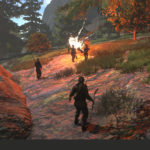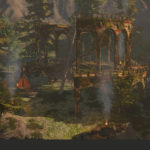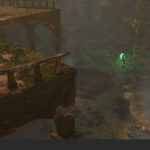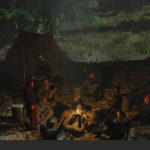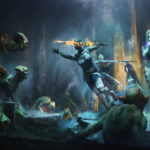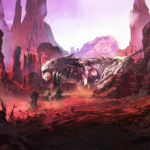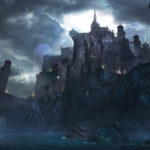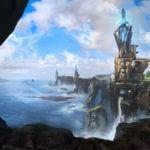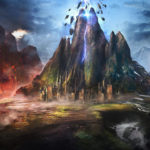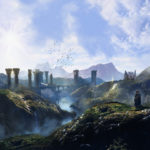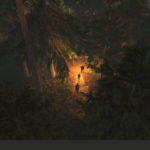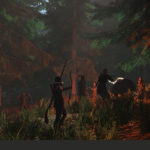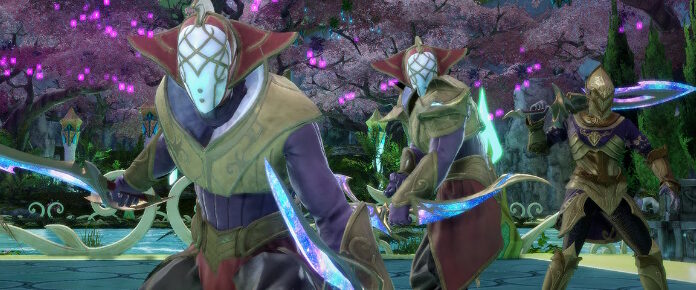
Upcoming MMORPG Saga of Lucimia has been somewhat dark over the last year as its developers hunkered down to develop rather than hype. But in 2020, the team has returned to the public eye, recently announcing a launch window for late 2021.
Stormhaven Games’ Tim Anderson kindly provided over 6000 words’ worth of answers to our questions on the game in its current stage, so we’ve divided our interview into two parts for reading’s sake. Today’s piece focuses on the more high-level development questions, while the second piece, slated for next week, covers gameplay. Let’s dig in!
MassivelyOP: A year ago, you put Lucimia into what you called stage two – more closed development – and you closed down the pre-order store too. I’m trying to imagine another game voluntarily shutting down a portal where players can give them money right now – and I’m failing. But the idea there was to give you time and space to develop as well as make use of investor funding. Can you discuss how the year of quiet went and how your funding is shaping up now?
Saga of Lucimia’s Tim Anderson: I don’t think you’ll find any other indie company who would be willing to shut down their preorder store for any length of time, let alone a year, because they need the incoming money to pay salaries. But that’s where we are unique in that none of the founders from Stormhaven Studios are drawing salaries; we’ve been working for free since we started this project, so six years ago now.
By being able to offset such a massive expenditure, we can instead make sure that the incoming money goes towards things like paying our contractors and covering business expenses. This has given us an incredible amount of flexibility in comparison to the traditional developer model where everyone draws industry-standard 80k-100k salaries per year. Basically, by the end of 2018 we were at a point where we could shut down the store and rely purely on investor funds to get through the entire 2019 calendar year and into part of 2020.
From there, it was literally just a matter of noses to the grindstone, day in and day out. Our early access community joins us for weekly testing sessions on Wednesday evenings, and they have been an invaluable tool in helping us shape the game and ensure that our mechanics not only look good on paper, but also translate into something that is fun for the end user when they log into the game.
There was a lot of backend work that went on during that time. We have been very open about the fact that none of us had developed an MMORPG before we started this project, so one of the areas we were lacking was networking experience. For the first few years we relied on third-party solutions just to help us get up and going and focus on building fundamentals in terms of mechanics.

Tim Anderson: One of the many benefits of Bobby (lead programmer and CTO Dr. Robert Thompson) working on Shroud of the Avatar for nearly three years (shout out to Chris [Spears] and Starr [Long] and Richard [Garriott] being so flexible with him working on two projects at once, nearly unheard of in this industry) was that he was able to get valuable hands-on experience with the networking side of things, and once we went into Stage Two he was able to turn around and build our own solution from the ground up, which is something that technically we should have done at the very beginning had we come into this project as veterans. You gotta pick your battles, though, so that was one thing we came into late.
The other thing that we’ve been focused on for the last year is just simply creating content. I talked about this in a recent podcast episode where I said that if you took World of Warcraft, Final Fantasy XIV, Lord of the Rings Online, and EverQuest II and put them all into the Unity engine using stock assets from the store, would you still be able to tell these games apart? The short answer is they all have completely different mechanics and they all play differently, but until a game has a defined art style it is very difficult for the average gamer to separate it from something else regardless of whether the mechanics are different. People tend to focus so much on the graphics when it comes to games, and art styles are indeed an important part of what set games apart.
Every single Unity-based project starts off using assets from the store. For example, there is a lamp post from a medieval asset pack that we have seen show up in no less than 15 different Unity games, including Pantheon and Shroud of the Avatar. And that’s one of the reasons we didn’t require an NDA during our pre-alpha stage, because we were using a lot of assets directly from the store; that’s what it’s there for, and it’s what nearly every Early Access game built using the Unity engine does. There was no reason for an NDA as we didn’t have anything original to keep behind closed doors, art-wise.
Back then, I would estimate that we were using perhaps 80% store-bought assets and 20% our own. Over the course of 2019, our art team was hard at work creating our own assets, and right now we are around a 50/50 split. Perhaps 60% unique and 40% store-bought. And the deeper we get into our development, the further we will continue to define our own unique art style and pull away from what you see with Shroud of the Avatar, Pantheon, Pillars of Eternity, or any other Unity-based game.
That’s also one of the reasons we are currently under NDA; we have a lot of art and mechanics that we want to keep under wraps. Things that further define us from other MMORPGs in development. And because we are presently covered via investors, we don’t need the pre-order money, so we haven’t needed to keep that store open and keep showing off progress for fundraising purposes.
Beyond all the backend work and art assets, there were also some changes to the world building design flow, upgrading tools, and more. We also didn’t find a VFX artist within the time frame we wanted last year, so I ended up taking that upon myself, taking a couple of months of classes in the latter part of 2019 to get things to where they are today; not perfect, but workable for an alpha product. Everyone just basically working their butts off outside of their day jobs. Day in, day out. Just like we’ve been doing the past (going on) six years.
As far as how our existing funding looks, we were busy bringing on new investors throughout the course of 2019 and as of the end of last year we reached a point where we had enough funding to take the game to completion with our existing workforce without needing any additional money to launch the game. Which is an extremely liberating place to be, knowing that we don’t actually need any additional funding to get the base game out the door.
Which is one of the major selling points with the investors we are currently discussing things with, because we don’t need additional money to complete the game. It’s all icing on the cake right now. We just signed a couple of new investors in February, we have ongoing pitches planned throughout the year, and we are reopening the preorder store on March 18.
All additional funding coming in at this point is going straight towards the hiring of what we consider to be “polish talent.” That is, team members who can add polish to the game, such as a graphics programmer, VFX artist, an animator, and/or an art lead who can handle both of the latter. Somewhere in there, another senior programmer at some point. Full details over on our careers page.

In February, Stormhaven discussed potentially changing the game’s planned business model, which came as a bit of a surprise to many folks, especially given Lucimia’s hardcore old-school MMORPG player bent and past arguments from the team that the reliable income source of subs was paramount (2018). Plus, at one point you mentioned that you had turned down two publisher offers specifically to avoid going free-to-play (2017). But the idea that it might have some sort of hybrid model – a way for people to play without a sub – is pretty common across the rest of the industry. What provoked the studio to put this topic back on the discussion floor? What kinds of hybrid models are you currently considering?
So I have to correct you a bit on this. First off, we actually started talking about the hybrid models with our community members over three years ago; the entire time we’ve been having the discussion internally, it’s been up on our FAQ page that we were prioritizing a subscription-based model but that we were debating the possibility of a hybrid model and would decide closer to launch.
So it’s not new news to anyone who is part of the Saga of Lucimia community as we’ve been having these conversations internally with folks for several years, and it’s been up on our FAQ until a couple of weeks back when we added a link to the Topic of the Week discussion. It only appears new to outsiders as it came up recently in our Topic of the Week series, which led to the public who weren’t on the inside track thinking that we were suddenly having some sort of change of heart. That’s absolutely not the case; again, this has been being discussed for more than three years with our community.
That being said, the ongoing conversation with our community members is that Plan A is the one-size-fits all model with a flat-rate subscription, Plan B is the Netflix-type model with tiered subscriptions, and Plan C would be some other type of hybrid that could, in fact, abandon the mandatory sub in favor of an optional subscription, akin to how ESO operates with their buy-to-play, optional sub model. But free to play hasn’t entered our minds as a valid option for our game, even though we are open to discussing things with our community members and the general public, because our company thrives on transparency. There’s nothing wrong with talking to people about the pros and cons of all of the different options.

You folks have picked Q4 2021 for your (very tentative) launch window, but you’ve been careful to point out that the date probably will change – certainly that’s been the case with every other crowdfunded MMORPG to date, some of them delaying years and years on end. What kinds of major issues could crop up in the next two years that could make your window drift? How “finished” does the game need to be before it can be set loose in the wild?
In regards to the types of issues that could crop up, there are things like me dying in a plane crash. An earthquake wiping Austin, Texas off the map. Coronavirus wiping out half our staff. These are all things that could absolutely impact the development of the game because a replacement would need to be found, and it could take a few months to find said replacement, and then another few months to onboard them and get them up to speed.
But apart from natural disasters or major health issues we really don’t see anything that would cause our launch window to be wildly off. Given that we are operating with such a small team, we have been extremely conscious of feature creep and each year at our annual design meeting we have snipped things from the project and considered them expansion territory, because it’s far more important for us to have a launched foundation than it is to have some sort of mythical perfection by the time we get to launch.
Which I think is one of the curses for most independent projects is they think that they can’t launch a less-than-perfect title in the current market or they will be automatically doomed to failure, so there is this mindset that you have to continually be pushing to create something that is “better” than the competition.
We don’t share that mindset. Seeking perfection is a lesson in futility. I’ve also been blessed to talk to a number of industry veterans who have launched titles over the past 30 years, had them take a look at our game, consulted with them, and the one thing that stands out to me more than anything else is that MMORPGs in particular are never finished at launch. Instead, every single MMORPG in the history of the genre has launched at point A, and then continue to add features over time.
There’s no such thing as “finished,” in essence, for MMORPGs. So for us, there are a few things that we consider mandatory for launch, and those are things that we are confident that we can get in within the timeframe that we have. The reason we have used the tentative wording is because we obviously need to allow ourselves some flexibility in there for unexpected circumstances and, if we have time and we think it’s worthwhile, then we can push in a few last minute features to really take us a step beyond.
Our only goal at this point is to have a fun, playable, bug-free game for launch, with our own unique lore, our own unique leveling process and progression system, and from there we will continue adding features over time and continuing to enhance our product as it ages. Just like every other MMORPG that has ever been published.

I’ve read a lot about “vertical slice” design vs. foundational design – the idea being that developers create a high-functioning but very narrow chunk of the game rather than a slow-simmering, multi-layered, full-bodied prototype. What you’re launching with stage three is as you’ve called it a vertical slice with a “rudimentary game loop.” I wonder what your thoughts on this type of game design are now that you’ve actually achieved it. For example, some game devs complain that they have to trash most of the work on the vertical slice when they retreat to the prototype (since you still have to bake the pie in order!). But without that slice, it’s hard to test and maybe more importantly show off the game’s capabilities. Where do you folks stand on this method of design? How is this working for you?
So we actually did this in reverse. We did all almost all our prototyping during pre-alpha, when we weren’t under NDA. So what we’re working on right now, which we are generically calling the first vertical slice because it’s terminology the general public is familiar with, is actually the starting zone for the live game with a rudimentary game loop.
Because we did all of the prototyping during the pre-alpha, once we finished the restructuring of the backend we were able to go right into implementing actual game content. From here, it’s literally just a matter of plugging in more Masteries, additional abilities, more VFX, better animations, more zones, more dungeons, and building upon this platform to flesh out the launch product that we are working towards a couple of years out from here.
So for us, we don’t have to trash anything because we’ve already done the bulk of our iteration-building during the pre-alpha stage. There were a lot of iterations in the early stages of combat, the Mastery system, the stat system, and so on and so forth, and we got those out of the way early on so now we can focus on just adding more content to the game.
It’s 100% forward progress in Stage Three + onwards.

